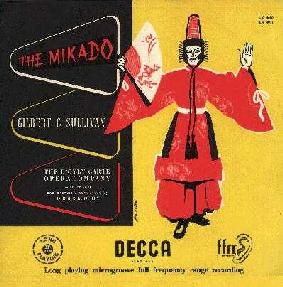The 1950 D'Oyly Carte Mikado
D'Oyly Carte Opera Company
Recorded in London, |
|
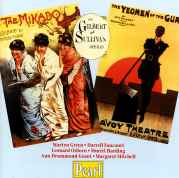 Pearl GEMS 0134 |
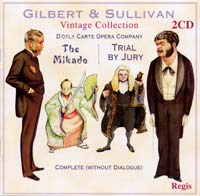 Regis RRC2041 |
This was the first of four recordings issued in in the busy year of 1950, and D'Oyly Carte's fourth recording of the post-war era. The Mikado was the last opera recorded before the war, and this set shares three principals (the Mikado, Ko-Ko and Go-To) and the conductor from the earlier 1936 recording. Although this set is a bit better sonically, the lineup on the earlier set is generally stronger.
The casting of two Go-To's is curious. Flynn sings the solo line in Act I ("Why, who are you who ask this question,") while Harris sings the bass line in the Act II madrigal. Harris was the stage Go-To of the time, though Flynn was the more senior Company member and had played the role earlier in his career. Perhaps Flynn was originally slated to sing the entire part but took ill during the recording sessions. Rollins and Witts correctly cite both singers, but only Flynn is credited on the album cover.
The recording is musically complete, aside from the fanfare before the Act II finale and the first part of the introduction to "Miya sama." The latter may have been a traditional performance cut at that time.
During the 1950's, Decca issued highlights of this recording (side 2), coupled with highlights of the 1951 Patience (side 1). The items included were as follows:
- If you want to know who we are
- A wandering minstrel, I
- Behold the Lord High Executioner
- Three little maids from school are we
- Here's a how-de-do
- A more humane Mikado
- On a tree by a river
- For he's gone and married Yum-Yum
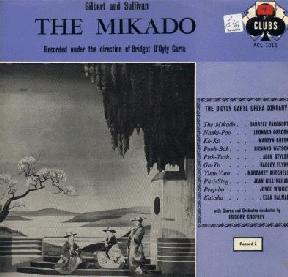 Decca Ace of Clubs ACL 1014/5 |
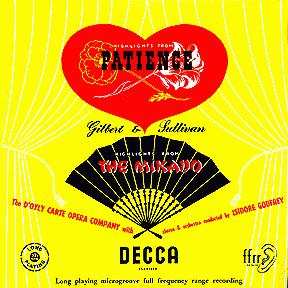 Decca (Australia) LKA 4068 |
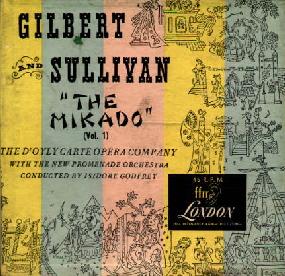 London LGF-30 |
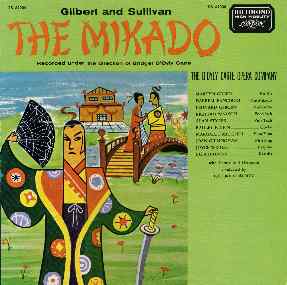 Richmond RS-62004 |
Review by Mel Moratti
This is a review of the first Naxos 1950s G & S release, with a comparison to Chris Webster's Sounds on CD release.
The Naxos release was mastered by David Lennick & Graham Newton with notes by Peter Dempsey (8110176/77). There are no technical notes. The Sounds on CD recording was mastered by Chris Webster with notes by David Steadman. Technical Notes by Jim Craig. (VGS 221)
I approached the first release of Naxos's G & S series with some excitement. Their recent transfers of Rachmaninov, Casals and the like have been excellent and the idea that they would strive for the same perfection with Gilbert and Sullivan had my hopes strongly motivated.
Alas, any hopes I had were dashed on first hearing. Being out of copyright anyone is now able to release these recordings which is great for the fans but disappointing if there is a lack of care in the mastering. Anyone who has read my previous reviews know my comments on the recent Pearl issues. To be brief the Naxos Mikado is no better than the Pearl except in price.
The comparisons are between the Sounds on CD release and all others — and there is no comparison!
Firstly for the non technical buff you will find that the Naxos recording played on a simple amplifier is flat with an extremely boxed in sound. There is no spread or depth. The oboe solo in the Overture sounds like it was recorded in another room. If you have a "simulated stereo" setting on your amplifier then the sound spread is improved. With the Sounds on CD recording there is spread on almost any setting you care to choose, even more so if using the "simulated stereo" button. I mention this only because most people just put a CD in their machines and press play.
The Sounds on CD release is clean with no hint of any pre-echo or distortion. The soloists are brightly lit and nicely forward. Because of the care Chris has taken in this transfer it does emphasise studio noise and other sounds but this is a minor quibble.
Tape hiss is prominent in "Comes a train/Three little maids" and one or two other places but this is worse on the Naxos CD.
For some idea of the cleanliness of the SOCD release sample the opening of the finale to Act 1. The cymbals are nicely positioned and even the full scale ensemble work is captured magnificently.
There is no need to comment to much on the performance itself. Martyn Green's Tit Willow is wonderful and some of the ensemble singing ("Brightly dawns") is extremely polished.
It is also nice to know who exactly is singing the role(s) of Go-To — mentioned by Chris but not by David Lennick.
In short, the release to have is the one on the Sounds on CD label. There is so much care and love in the transfers that it is strange that the recording companies are not knocking down Chris's door to get him to work for them.
Comments from Chris Webster
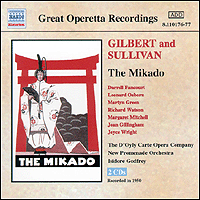 Naxos 8.110176-77 |
[Editor's Note: Chris and I had some misgivings about posting the following, as it might be misperceived as a conflict of interest. Nevertheless, as most of what he wrote concerned what are indisputably factual errors in Naxos's sleeve notes, I felt that Chris's comments ought to be seen. Reasonable minds can differ on the merits of different transfer engineering strategies, but accurate sleeve notes ought to be a minimum requirement for any recording company, particularly in a branch of the field where the information is so easy to come by.]
Mel Moratti posted a comparative review between the Naxos Mikado and my SOCD issue, and his favour once again fell on my issue for which I thank him. My own opinion is that the difference is similar to hearing a radio broadcast of the recording on a transistor radio and then hearing a broadcast of the same recording on good hi-fi equipment. I really don't know what Naxos's criteria is for vintage recordings, but for some reason they seem to have knocked half of the quality of the recorded sound out of them. This applies to Pinafore too. What makes this more disturbing is that the sleeve notes actually point out the these recordings were ahead of their time sonically, thus making us think that we are listening to Decca's wonderful FFRR sound, and yet they have put them into the same league soundwise as recordings made many years earlier.
Unfortunately the average member of the public will not realise this, and when listening he or she will simply think that this old sort of sound is how the recordings are which is most definitely not the case. I have to say that I was taken in myself the other day when I bought the Naxos transfer of a late 30s recording of Lucia di Lammermoor. At first I thought it sounded quite nice for an old recording until I pulled out my 1950s LP transfers from the mother company of the same recording and realised that although Naxos's transferors had done a good job in removing unwanted surface noise, most of the actual recorded sound just wasn't present on the Naxos issue. Even though I had at first thought it acceptable, from now on I shall stick to my LPs in spite of the noisy surfaces (the recorded sound is far more important than the removal of surface noise), but how many people are going to buy these recordings in good faith believing them to be accurate representations of these historical treasures when in fact they are a shadow of them. My suggestion that this result is perhaps a criteria of Naxos is made because the G&S transfers and the Lucia transfer are not done by the same transferor.
What I am also very concerned about are the inaccuracies found in the Naxos sleevenotes and the details given on their website The G&S sleevenotes are written by Peter Dempsey who, I read somewhere (perhaps on the Naxos website), is an enthusiast of old recordings and also a researcher into them. Well, quite frankly I have to say that his research, based on the factual errors that he has incorporated, is just not good enough. I have three Naxos CDs that he has prepared notes for, and all of them are littered with errors. I do not know whether he also contributed the additional information that appears on the website, but here are some examples of the errors that have occurred between the sleevenotes and website details for the G&S issues.
- Darrell Fancourt is a tenor. (He was a bass-baritone.)
- Darrell Fancourt recorded the role of The Mikado twice. (He recorded it three times.)
- Martyn Green played "the title role" in the 1930s Mikado film. (He played Ko-Ko.)
- Ella Hallman should read Ella Halman.
- Henry Lytton appeared in the acoustic recording of Pinafore. (He did not, but he played it on the electric recording.)
- Pinafore was recorded with…wait for it…the Dallas Symphony Orchestra!!
- Pinafore is dated as being from 1948 (this actually appears in the description on the front cover).
- Pinafore was recorded at Kingsway Hall.
With the exception of the Halman error (which I wouldn't have bothered mentioning if it was the only one), all of the others are historical inaccuracies that I find unforgivable, particularly in an issue from such a widely distributed label as Naxos. These are just the errors that I spotted. There may be others that I missed, but those mentioned above positively shouted out at me.
On the last two points concerning the date and location of the Pinafore recording, there is very little information at my disposal to disprove the given details other than the existing published discographies. Maybe Mr Dempsey has discovered something that I and other researchers have not, and if he has I offer him my congratulations and an unqualified apology for doubting his information, but until evidence can be shown that these two points are correct I shall stand by my existing belief that Pinafore was recorded in 1949 at the Decca Studios in Hampstead. If Pinafore had been recorded in 1948 then surely Tom Round rather than Leonard Osborn would have sung Ralph, and I think that the Kingsway Hall reference is probably just the researcher getting confused with the 1930 Pinafore recording which was recorded there.
Re Martyn playing role of The Mikado. This is worded differently in each booklet. The Mikado booklet states "Green's masterly performance in the title role…is mercifully preserved on celluloid… In the present 1950 Decca audio recording he sings Ko-Ko". In the Pinafore booklet Green is described thus: "Perhaps nowadays remembered solely for his subtly underplayed Mikado in the 1939 British film…" !!!
Another point re The Mikado. There is no mention anywhere of Go-To, neither in the musical item details or the cast list. In fact the item details would have us believe that Pish-Tush sings in the madrigal on this recording, in which Pish-Tush is played by Alan Styler who does not sing in the madrigal. There did used to be some confusion concerning the casting of Go-To which is sorted now, but Naxos did not address this issue at all. Instead they completely omitted him and erroneously gave one of his appearances to a character sung by a completely different person.
I mentioned earlier that I had three Naxos CDs with inaccurate notes by Peter Dempsey. In case anyone is interested the third is a George Formby CD in which Dempsey claims that Formby was initially with Decca for four years (he was with them for just under three), he died at his home in Penwortham (he died at St Joseph's hospital in Preston), he was 57 when he died (he was 56) and just before he died "he managed to record one last LP for Pye" (he recorded two sides for a Pye single, and he had never recorded any LP before). Also their publicity for this disc implied that all tracks were recorded with Jack Hylton, whereas he played for just a few of the early Decca recordings. In case anyone thinks this is sour grapes, I can tell you that it definitely isn't. I've had my main sales now from the two G&S recordings in question, and Naxos's issues will not make much difference to me. Even if I had no professional connection with these recordings I would still be pointing out the above points because they are valid points to be raised, and they are matters that have concerned me greatly simply because of my love for these recordings.
Review by J Antony Gower
Following recent postings about the reissues on CD of the 1949/1950 Decca recordings of H.M.S. Pinafore and The Mikado, I recently bought the Naxos version of The Mikado, to compare with the version from Sounds on CD issued a few months earlier. Whilst a very efficient job has been done by Naxos in removing surface noise and other extraneous pops, clicks, etc., inherent in the LP medium, the "restoration" engineers also seem to have removed all the sparkle and freshness which was characteristic of the wonderful new Decca ffrr (full frequency range recording) sound. There is really no comparison with the SOCD version which has been lovingly restored: all the subtle nuances of the original recorded sound have been preserved and many of the Decca "wobblies" have either been corrected or greatly improved. A must for any Savoy collection.
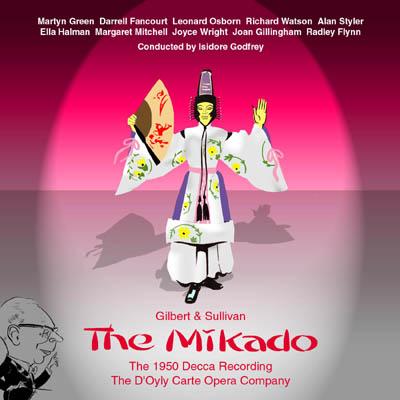 Sounds on CD VGS 221. (Cover art by Matt Bland.) |
| Date | Label | Format | Number | Comments |
|---|---|---|---|---|
| 1950 | Decca | 78rpm | AK 2388/98 | Automatic side couplings |
| Mono LP | LK 4010/11 | |||
| LKA 4010/11 | Australian issue | |||
| London | 78rpm | Album LA-230 | Automatic side couplings [record numbers needed] | |
| 45rpm | 40143/53 in Album LGF 30 |
Automatic side couplings. Published in two volumes of six and five discs each. | ||
| Mono LP | LLP 189/190 XLLP 189/190 |
|||
| ca. 1953 | London | Mono LP | LL 189/90 | |
| 1953 | Decca | Mono LP | LK 4068 | Mikado and Patience highlights highlights. Note that LKA 4068 was an Australian issue. |
| LKA 4068 | ||||
| London | Mono LP | LL 782 | ||
| ca. 1956-7 | London | Mono LP | A-4203 | |
| 1957-8 | London | 45rpm | REP.8010 | Three 45rpm singles, titled The Mikado, vol. 1, 2 and 3 respectively, each with two or three songs per side. These were sold separately. |
| REP.8011 | ||||
| REP.8012 | ||||
| Late 1950s | London | Mono LP | 5087 | Mikado and Patience highlights |
| 1960 | Decca Ace of Clubs | Mono LP | ACL 1014/5 | |
| ACLA 1014/5 | Australian issue | |||
| 1960s | Richmond | Mono LP | RS 62004 | |
| R 23055 | Mikado and Patience highlights | |||
| 1979 | Decca | Stereo LP (simulated) |
DPA 3049/50 | |
| ca. 1980 | Decca Viva | Stereo LP (simulated) |
AUS 1012/3 | Australia/New Zealand issue |
| Cassette | KAUS 1012/3 | |||
| 1980s | Price-Less | Cassette | C 87573 | |
| 2001 | Sounds on CD | CD | VGS 221 | |
| 2001 | Pearl | CD | GEMS 0134 | With 1950 Yeomen |
| 2001 | Regis | CD | RRC2041 | With 1949 Trial by Jury |
| 2001 | Naxos | CD | 8.110176-77 | |
| 2004 | AVID | CD | AMBX138 | 10-CD set containing the entire nine-opera series recorded 1949–51, plus Pineapple Poll, the Overture ’Di Ballo’, and orchestral highlights (S. Robinson) from Pinafore and Yeomen |
| Side Nbr | Matrix Number |
Selection |
|---|---|---|
| 1 | AR14677 | Overture, part 1 |
| 2 | AR14678 | Overture, part 2 |
| 3 | AR14679 | If you want to know who we are |
| 4 | AR14680 | A wandering minstrel I |
| 5 | AR14681 | Our great Mikado, virtuous man |
| 6 | AR14682 | Young man, despair |
| 7 | AR14683 | Behold the Lord High Executioner |
| 8 | AR14684 | Comes a train of little ladies |
| 9 | AR14685 | So please you, Sir |
| 10 | AR14686 | I am so proud |
| 11 | AR14687 | With aspect stern and gloomy stride |
| 12 | AR14688 | Your revels cease! |
| 13 | AR14689 | The hour of gladness |
| 14 | AR14690 | Braid the raven hair |
| 15 | AR14691 | The sun, whose rays |
| 16 | AR14692 | Brightly dawns our wedding day |
| 17 | AR14693 | Here's a how-de-do! |
| 18 | AR14694 | A more humane Mikado |
| 19 | AR14695 | The criminal cried |
| 20 | AR14696 | See how the Fates their gifts allot |
| 21 | AR14697 | Alone, and yet alive! |
| 22 | AR14698 | There is beauty in the bellow of the blast |
- For a discussion of the matrix numbers in these sets, see the matrix numbers discussion page.
